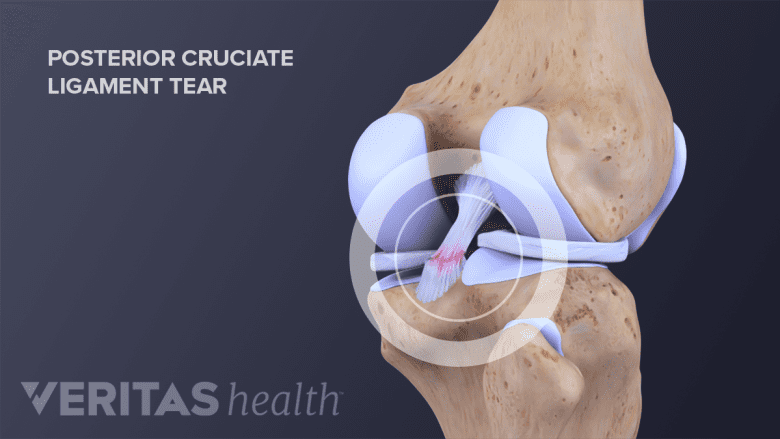Posterior cruciate ligament (PCL) injuries can go undiagnosed because they are generally less painful and do not cause as much instability as other knee ligament injuries, such as an anterior cruciate ligament (ACL) tear or medial collateral ligament (MCL) tear. In fact, it is possible for some PCL tears to go undiagnosed for weeks or even years. 1Lee BK, Nam SW. Rupture of posterior cruciate ligament: diagnosis and treatment principles. Knee Surg Relat Res. 2011;23(3):135–141. doi:10.5792/ksrr.2011.23.3.135
The PCL of the knee can be injured during contact sports, such as football, soccer and skiing, as well as during a car accident. PCL injuries commonly occur in the following instances:
- A direct blow to the knee, such as when a soccer player falls onto a bent knee
- Over-twisting or hyperextending the knee, such as while skiing or quickly changing direction on one foot
- Landing on the front of the shinbone, such as when a dancer is coming down from a leap
- A simple misstep that results in falling on a bent knee
- A bent knee hitting the dashboard during a car accident
While generally less painful than other knee ligament tears, a PCL tear can still cause pain, swelling, and decreased range of motion.

PCL ligament tear can cause knee instability, pain, and reduced range of motion.
In This Article:
What Is the PCL?
Ligaments are strong fibrous bands that connect bone to other bones. The posterior cruciate ligament is the strongest of the 4 main stabilizing ligaments of the knee.
The PCL is located within the knee joint, connecting the bottom of the femur (thigh bone) with the top of the tibia (shinbone). The PCL and ACL crisscross to form an X (cruciate comes from the Latin word for cross). Together, the PCL and ACL control back-and-forth movement.
See Guide to Knee Joint Anatomy
The other two ligaments, the MCL and lateral collateral ligament (LCL), are found on the either side of the knee and help prevent side-to-side motion.
The PCL Injury Grading System
Ligament injures are referred to as sprains or tears—a sprain typically refers to a ligament that is overstretched, while a tear implies the partial or complete separation of ligament tissue. Some doctors may refer to a PCL injury’s “grade,” which refers to its severity:
- Grade I sprains refer to a slightly or mildly overstretched PCL that is still able to keep the knee stable.
- Grade II sprains refer to a ligament that has been stretched or partially torn to the point of looseness, causing some knee instability. These injuries are sometimes referred to as partial tears.
- Grade III sprains refer to a complete tear of the PCL. The ligament has been split into 2 pieces and causes knee joint instability.
- Grade IV sprains refer to a PCL tear where other ligament injuries are present.
PCL sprains may be an isolated incident or they may occur along with other knee ligaments injuries, such as an ACL or MCL tear. These tears produce their own symptoms that are often similar and sometimes hard to distinguish from PCL tear symptoms.
- 1 Lee BK, Nam SW. Rupture of posterior cruciate ligament: diagnosis and treatment principles. Knee Surg Relat Res. 2011;23(3):135–141. doi:10.5792/ksrr.2011.23.3.135


